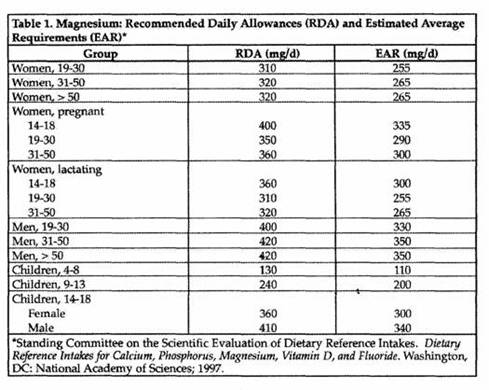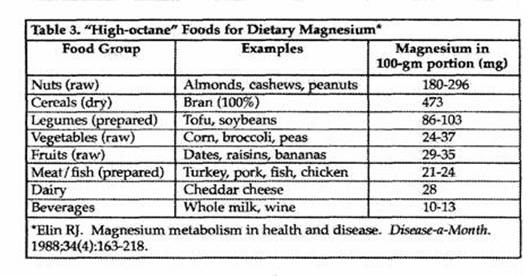|
In general magnesium is used in engineering and in health, especially in medicine. Magnesium found an exceptional place in curing various diseases and is thus included into many medicines for its exceptional properties. It's the fourth most abundant part from human's body. Nearly 50 percent of the body's magnesium is contained within its cells.
Important to feeding and medicine, magnesium, like calcium and phosphorus, is considered a major mineral. Magnesium carbonate and sulfate forms have been used for centuries. Its main purpose was a resource as a laxative.
Magnesium is an important element in the body because it activates or is involved in many basic processes or functions, like:
1. Cofactor for over 300 enzymes;
2. Oxidation of fatty acids;
3. Activation of amino acids;
4. Synthesis and breakdown of DNA;
5. Neurotransmission;
6. Immune function;
7. Interactions with other nutrients, including potassium, vitamin B6, and boron.
Magnesium has a number of general uses, primarily in standard allopathic medicine, but also in some alternative therapies. There are some statistics facts about magnesium in food and nutrition. They are ordered by different properties from the US National Academy of Sciences:
Infants and children
0-6 months - 30 mg;
7-12 months - 75 mg;
1-3 years - 80 mg;
4-8 years - 130 mg;
9-13 years - 240 mg.
Males
14-18 years - 410 mg;
19-30 years - 400 mg;
over 30 years - 420 mg.
Females
14-18 years - 360 mg;
19-30 years - 310 mg;
over 30 years - 320 mg.
The tolerable upper limits apply only to magnesium taken as a dietary supplement or given for medical reasons, since no toxicity from magnesium occurring naturally in foods has been reported. The tolerable upper limits for magnesium are:
1-3 years - 65 mg;
4-8 years - 110 mg;
9 years and over - 350 mg.
Good dietary sources of magnesium include nuts; dried peas and beans; whole grain cereals such as oatmeal, millet, and brown rice; dark green vegetables; bone meal; blackstrap molasses and soy products. Dark green vegetables are important sources of magnesium because it is the central atom in the structure of chlorophyll. You can add magnesium to your diet also by hard or mineral water.
Magnesium deficiency in a healthy person is unusual because normal kidneys are very efficient in keeping magnesium levels balanced.
We called this 'hypomagnesaemia' and mainly it was caused by disease like chronic diarrhea, hyperparathyroidism, or chronic alcoholism. Sometimes it's a result of antibiotics or a cancer medication. Hypomagnesaemia is definite by symptoms include disturbances of the heart rhythm, muscle tremors, seizures, hyperactive reflexes and conditions like depression or agitation.
Hypomagnesaemia can be treated with either oral or intravenous preparations containing magnesium.
Magnesium is something recommended in everyday live. But there are daily allowance for it.
Ensuring adequate magnesium intake, either through dietary sources of magnesium or the use of oral magnesium supplements, constitutes a major step toward "wellness" that is justified by scientific and clinical data. Suboptimal intake of magnesium has been associated with a number of extremely prevalent and potentially serious conditions. The Recommended Daily Allowance (RDA) of magnesium gives us a precise answer to the question why chronic latent magnesium deficiency is important and what can be done about it. We use the RDA dietary to provide an enough amount of a nutrient for nearly all the population. RDAs are specific to life stages and gender. The major significance of magnesium gives results in 1997. Then in Institute of Medicine and the National Academy of Sciences magnesium was accepted like essential nutrient for good health. The RDA of magnesium was raised by 15%, to approximately 6 mg/kg/day. For men, this means an increase from 350 mg/day to 420 mg/day, and for women from 280 mg/day to 320 mg/day. Here you can see that:

The US National Academy of Sciences and the Institute of Medicine reevaluate RDAs and their supporting data every decade. Review of scientific information motivated the magnesium intake upgrade promulgated by the Institute of Medicine in its 1997 Dietary Reference Intakes for Calcium, Phosphorus, Magnesium, Vitamin D, and Fluoride. The experimental data on magnesium come from dietary balance studies involving several different magnesium intake levels under conditions in which diets were either constant, and controlled at clinical research centers, or self-selected in the community.
These studies help to provide a more accurate and reliable estimate of dietary magnesium sufficiency, involved men and women of all ages. Magnesium content of foods was measured using atomic absorption spectroscopy, and the study period was preceded by at least a 12-day lead-in period to allow equilibration of magnesium in the body.
Today, the proportion of individuals consuming their RDA of magnesium remains low. Most people take in around 300 mg/day - estimates range from below 300 mg/day to around 325 mg/day. According to the US Department of Agricultures 1994 Continuing Survey of Food intakes by Individuals, the mean magnesium intake by males aged nine and older was 323 mg/day - far below today's RDA of 420 mg/day. Similarly, for women older than nine, the mean intake was 228 mg/day - again, significantly below the RDA of 320 mg/day.
Intake decreases significantly in persons of age 70 and older - precisely those at highest risk for many of the diseases associated with chronic latent magnesium deficiency. Adolescent and adult women tend to take in suboptimal amounts of dietary magnesium. Certain ethnic groups appear to have lower magnesium intake than the general population. According to the National Health and Nutrition Examination Survey (NHANES III) during 1988-1991, magnesium intake is particularly low in non-Hispanic blacks.
It is taken centuries till the magnesium become a necessary part of dietary habits and food preparation. Magnesium was absence of processed foods, before. Vegetarians, who eat mostly fresh foods, consume large amounts of magnesium. But now we eat mostly fast food or fried food. Nation's eating habits have gone and the food content magnesium has plummeted.
The sodium and phosphate found in high amounts in many of today's processed and prepared foods hinder the use of magnesium in the body. A fast-food hamburger for example, packs a double whammy; virtually devoid of magnesium itself, it is extremely high in sodium, which helps magnesium loss. Phosphates are found in soft drinks, especially cola beverages (essentially devoid of nutritional value), and polyphosphate preservatives are general in baked goods. All these allow us to say that today magnesium is less consume by people and we can summary that magnesium supplementation, either in the form of oral supplements or specific magnesium-rich foods may be of value to many people, especially patients who have or are at risk for many prevalent chronic diseases.
Magnesium deficiency is something usual for the modern world but not good for people's health. Chronic latent magnesium deficiency is the inadequate intake or retention of magnesium in association with a constellation of diseases or risk for them. Magnesium deficit is a risk factor for every person. The diseases results of magnesium insufficiency are arrhythmias, coronary artery disease (CAD), diabetes mellitus, hypertension, migraine, osteoporosis and others. Clinical and population-based studies have established links between inadequate magnesium intake and elevated risk for cardiovascular diseases. In the NHANES I is demonstrated inverse relationships between total serum magnesium concentration and risks of coronary heart and vascular disease deaths and hospitalizations. Important for medicine was discovered that blood pressure tended to be lower in people whose fruit and vegetable intake - and therefore magnesium intake - was high.
The scientists outlined the strong link between magnesium and hypertension and found that the use of oral magnesium reduced the risk of acute myocardial infarction in patients with known CAD. The potential was discovered for event-rate reduction by oral magnesium supplementation to hold for patients at risk for cardiac arrhythmias, including patients who have congestive heart failure. There is news for the connection between osteoporosis and magnesium nowadays. A year ago, a subset analysis of the Framingham Heart Study showed that dietary intake of magnesium was directly related to bone mineral density (BMD) and reduced declines in BMD in men and women. Many experiments including magnesium, especially for bone health were done. It is reasonable to suspect chronic latent magnesium deficiency in any patient with cardiovascular disease, osteoporosis, or premenstrual syndrome, diabetes mellitus, migraine or risk factors for any of these conditions. The contact between patient and development of magnesium usefulness improve that dietary intake of magnesium is necessary for people's health. We can take all needed magnesium provided by oral magnesium supplementation. Next table shows important magnesium-content food:

Magnesium-curable diseases are:
1. Aging;
2. Aggressive Behavior (Violence);
3. Alcoholism;
4. Amyotrophic Lateral Sclerosis;
5. Alzheimer's Disease;
6. Arrhythmia;
7. Asthma;
8. Attention Deficit Disorder;
9. Autism;
10. Cancer;
11. Cerebral Palsy;
12. Cerebrovascular;
13. Chemical Sensitivity;
14. Chronic Fatigue;
15. Cluster Headaches;
16. Cocaine-related Stroke;
17. Constipation;
18. Cramps;
19. Diabetes;
20. Fibromyalgia;
21. Fluoride Toxicity;
22. Head Injuries, Central Nervous System Injuries;
23. Heart-Related Conditions;
24. HIV, AIDS;
25. Hypertension;
26. Kidney Stones;
27. Magnesium Deficiency (Hypomagnesemia);
28. Menopause;
29. Migraine;
30. Mitral Valve Prolapse;
31. Multiple Sclerosis;
32. Nystagmus;
33. Osteoporosis;
34. Peripheral vascular disease;
35. Pregnancy-related problems, Eclampsia;
36. Premenstrual Syndrome;
37. Psychiatric Disorders;
38. Repetitive Strain Injury;
39. Rheumatoid Arthritis;
40. Sickle Cell Disease;
41. SIDS;
42. Sports-related problems;
43. Stress;
44. Tetanus;
45. TMJ;
46. Toxic Shock.
Source Magnesium.com
|

